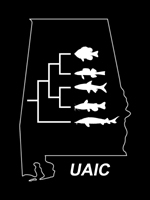|
||
|
|
||
|
|
||
|
|
||
|
The State of Alabama contains the most diverse fish fauna of North America. The University of Alabama Ichthyological Collection (UAIC) documents this diversity and is one of the largest educational and research collections of fishes in the southeastern United States. This nationally and internationally recognized biological resource includes over one million preserved, skeletal, and frozen specimens, some dating back to the mid 1900's, and is the best single resource documenting past and present distributions and abundances of fishes in the State. While the primary emphasis of UAIC has been to serve in the study and documentation of Alabama freshwater and marine fishes, the collection contains much more diversity. A significant number of fish species inhabiting aquatic ecosystems from other areas in North America are represented in the collection, as well as collections from Central and South America, Europe, and Asia.
During its formative years the collection was curated by its founder, the late naturalist Dr. Ralph L. Chermock (1918-1977). From 1959-1986 Dr. H. T. Boschung, UA Professor Emeritus, was responsible for the collection and expanded its holdings with many collections from throughout Alabama, as well as Mississippi and Tennessee, and expeditions to South America. Between 1987 and 2001, the collection was curated by Dr. Richard L. Mayden, Curator, and Mr. Bernard R. Kuhajda, Collections Manager. During those years the collection expanded tremendously from expeditions and investigations throughout waterways in Alabama and neighboring southeastern States, as well as limited studies in other areas in North and Central America. Recently, the collection has also been expanded through the adoption of other small, orphaned collections from the southeast. Under Dr. Mayden's supervision the collection also expanded into housing vital frozen tissues of fishes useful in molecular and biochemical studies. As such, UAIC has one of the largest and most diverse frozen tissue collection in the world and has been designated a permanent repository by the U.S. Fish and Wildlife Service for all endangered sturgeon specimens and tissues. In August 2002, Dr. Phillip Harris became UAIC's fourth Curator. In 1997, UAIC moved from the Department of Biological Sciences building into the new Scientific Collections Facility (now Mary Harmon Bryant Hall) where a new laboratory complex fosters education and research in ichthyology and biodiversity associated with the collection. This facility also contains the Steven Johnson Molecular Systematics Laboratory for University of Alabama faculty and graduate students interested in conducting molecular systematic research with museum collections. This invaluable collection of fishes serves many functions. The specimens and associated ecological data serve to inventory the diversity from the state and the general health of its ecosystems since the middle 1900's. The collections provide extensive teaching materials and data that have been invaluable in education of K-12 students and upwards to the university level. While these fish specimens form an essential resource in university-level courses, theses, and dissertations, each year hundreds of elementary, middle, and high school students benefit from the collection through an extraordinary educational program, "The Traveling Fish Show". The diversity of specimens and the historical significance of the collection provides valuable research materials and information to researchers from UA and other institutions and environmental, federal, and state agencies. Among the most important holdings in the collection are type materials, or the original specimens used in the descriptions of several new species from North American. The ichthyological collection is used regularly to study ecological and environmental questions, human-related questions, and questions pertaining to the formation and maintenance of the existing biodiversity. |
||
|
|
||
|
|
||
| © Phillip Harris 2006 |
